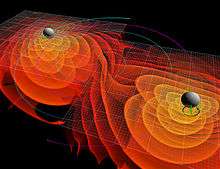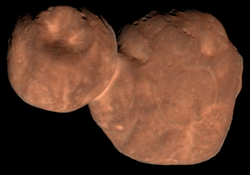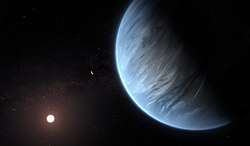GW190521g
GW 19009521g[2] (or GW 190521)[3] was a gravitational wave (GW) signal observed by the LIGO and Virgo detectors on 21 May 2019 at 03:02:29 UTC,[3] and associated with the astronomical superevent S190521g, located 12.8 billion light years away, in location area 765 deg2[n 1] towards Coma Berenices, Canes Venatici, or Phoenix.[1][2][4][5]
| Instrument | LIGO, Virgo[1][2] |
|---|---|
| Right ascension | ??h ??m ??.??s |
| Declination | −??° ??′ ??.?″ |
| Epoch | J2000.0 |
| Distance | 3,931 megaparsecs (12,820 Mly)[1][3] |
Discovery

In June 2020, astronomers, using the Zwicky Transient Facility (ZTF) located at Palomar Observatory near California, reported observational details, related to the detection of the gravitational wave GW190521g, of the merging of two black holes, within the vicinity of a very large third black hole, that, uncharacteristically, emitted a flash of light, the first-ever observed in the merger of two black holes by astronomers.[2][4][6][7] Mergers of black holes do not typically emit any light whatsoever. Researchers think a unique event occurred with the three black holes: the third larger supermassive black hole may have affected the merging of the two smaller black holes, sending the newly formed black hole hurtling through the related accretion disk, disrupting the disk material and producing a flare of light. The newly formed black hole was 100 times the mass of the sun and traveled at 200 km/s (120 mi/s) through the disk, according to the astronomers.[8]
According to Matthew Graham, lead astronomer for the study, “This supermassive black hole was burbling along for years before this more abrupt flare. The flare occurred on the right timescale, and in the right location, to be coincident with the gravitational-wave event. In our study, we conclude that the flare is likely the result of a black hole merger, but we cannot completely rule out other possibilities.”[8]
The astronomers predict a repeat flare of light in this source, due to a re-encountering with the related accretion disk, in about 1.6 years.[6] If the predicted flare is observed, then the initial clams of the astronomers would be further supported.[8]
See also
Notes
- The area of the sky within which it was possible to localize the source.
References
- Staff (21 May 2019). "Superevent info - S190521g". LIGO. Retrieved 25 June 2020.
- Cofield, Calla (25 June 2020). "Black Hole Collision May Have Exploded With Light". NASA. Retrieved 25 June 2020.
- Staff (2020). "GW trigger S190521g ('GW 190521')". University of Leicester. Retrieved 26 June 2020.
- Overbye, Dennis (25 June 2020). "Two Black Holes Colliding Not Enough? Make It Three - Astronomers claim to have seen a flash from the merger of two black holes within the maelstrom of a third, far bigger one". The New York Times. Retrieved 25 June 2020.
- Gradute Center, CUNY (25 June 2020). "Black hole collision may have exploded with light". Phys.org. Retrieved 26 June 2020.
- Grham, M.J.; et al. (25 June 2020). "Candidate Electromagnetic Counterpart to the Binary Black Hole Merger Gravitational-Wave Event S190521g". Physical Review Letters. 124 (25). doi:10.1103/PhysRevLett.124.251102. Retrieved 25 June 2020.
- Staff (26 June 2020). "Black hole collision may have exploded with light". ScienceDaily. Retrieved 26 June 2020.
- Carpineti, Alfredo (25 June 2020). "Astronomers May Have Observed The First Flare From A Black Hole Collision". IFLScience. Retrieved 26 June 2020.


